|
Rats
| Symptoms |
|
| |
|
Symptoms:
Chopped young seedlings
Irregular cuttings of stem
Patches of depressions seen in the field at early stage
Chewed developing buds or ripening grains
Tillers cut near base at 45° angle. Cut tillers may be seen in patches.
At ripening stage, the ear heads are cut and stored in the burrows.
Nature of damage:
The rats enter the nurseries and nibble the seeds.
After transplantation, the seedlings are cut.
At the shoot blade stage, the culm is cut and
At ripening stage, the ear heads are cut and stored in the burrows.
|
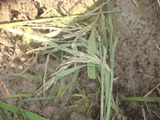 |
| Earheads are cut and stored in the burrows |
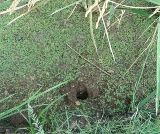 |
| Holes or depressions seen in the field |
|
| Top |
| |
Identification of pest |
|
|
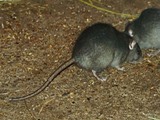 |
- Lesser bandicoot / mole rat / field rat, Bandicota bengalensis
- Grass rat, Millardia meltada
- Gerbil rat, Tatera cuvieri, T. indica
- Indian field mouse, Mus booduga
- Rat (Rattus rattus rufuscens, Rattus meltada)
Rice field rats are black to brown in color. They have scaly, thinly furred tails and distinctive chisel-like incisors. The rice field rat, R. argentiventer, is the major rodent pest and is distinguished by a tuft of red hair at the base of its ears, fur on back orange-brown flecked with black, and a silvery white ventrum.
Factors favoring pest development:
lowland irrigated rice crops both the wet and dry seasons
availability of food, water, and shelter
presence of breeding sites
presence of major channels and village gardens |
| Black Rat |
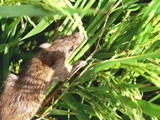 |
| Rice field rat |
|
| Top |
| Management Strategies |
|
- Physical control includes hunting, rat drives, digging, and exclusion.
- Narrow bund maintenance (45 × 30 cm).
- Digging burrows during the off season and killing, poison baiting with zinc phosphide or bromadiolone 3 to 4 weeks after planting, and setting up of Thanjavur or bamboo bow traps (100 nos/ha) are to be followed in sequence.
- Locate the burrows opened by the rats and insert two pellets each of 0.5 or 0.6g of aluminium phosphide per burrow as deep into the burrow as possible and plug the entrance with a mud ball.
- Poison bait at 1 part zinc phosphide with 49 parts popped corn/rice/dry fish or bromodialone 0.25 w/w (1:49) at 0.005%. Mix one part of bromodialone + 49 parts of bait and keep inside the field.
- Warfarin 0.5% 1 part with 19 parts of popped corn/rice/dry fish and keep in field.
- Setting up of owl perches at 40 -50/ha.
- Wildcats, snakes, and birds are predators of rice field rats.
|
 |
| Effect of Poison Bait1 |
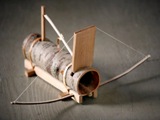 |
| Bow trap |
| Top |
|






